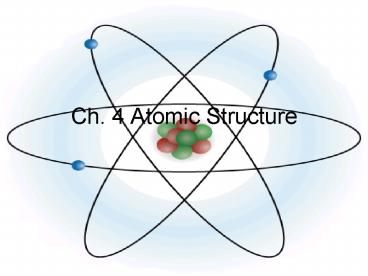Ch' 4 Atomic Structure - PowerPoint PPT Presentation
1 / 19
Title:
Ch' 4 Atomic Structure
Description:
Democritus (460 B.C.-370 B.C) First to suggest existence of atoms ... Elements are made up of tiny particles called atoms. All atoms of a given element are identical ... – PowerPoint PPT presentation
Number of Views:39
Avg rating:3.0/5.0
Title: Ch' 4 Atomic Structure
1
Ch. 4 Atomic Structure
2
Atoms
- The smallest particle of an element that retains
its identity in a chemical reaction
Iron Atoms on Copper
3
Democritus (460 B.C.-370 B.C)
- First to suggest existence of atoms
- Said atoms are indivisible and indestructible
4
Daltons Atomic Theory 1766-1844
- Elements are made up of tiny particles called
atoms - All atoms of a given element are identical
- All atoms of a given element are different from
those of a different element - Atoms combine to form compounds. These compounds
contain specific ratios. - Atoms are indivisible by chemical processes- a
solid indivisible mass
5
Errors in Daltons Theory
- Atoms are now known to be divisible
- Protons
- Neutrons
- Electrons
6
Electrons
- Negatively charged subatomic particles
- (-1)
- Discovered by J.J. Thompson
7
J.J Thomson 1856-1940
- Discovered the electron in 1897 using a cathode
ray tube - Cathode ray repelled by the negative charge of
electric field
8
Protons
- Positively charged subatomic particles (1)
- Discovered in 1886 by Eugene Goldstein ? Canal
Rays travel in opposite directions as cathode
rays
9
Neutrons
- Subatomic particles with no charge but mass
nearly equal to that of a proton
10
Ernest Rutherford 1871-1937
- Proposed the nuclear atom-electrons surround a
nucleus - 1911 directed a particles at gold foil- some were
reflected or deflected, indicating a concentrated
positive charge - Discovered the proton-later experiments showed
the presence of neutrons
11
Nucleus
- Protons and Neutrons are located in the nucleus
12
Atomic Number
- The number of protons in the nucleus of an atom
- Elements are different because they contain
different numbers of protons
13
Mass Number
- The total number of protons and neutrons in an
atom
Mass Number
14
Calculating Neutrons
6 Neutrons
15
Isotopes
- Atoms that have the same number of protons but
different numbers of neutrons - Because they have different numbers of neutrons
they also have different mass numbers
16
Atomic Mass
- Is the weighted average mass of the atoms in a
naturally occurring sample of the element - Reflects both the mass and the relative abundance
of the isotopes as they occur in nature
17
Atomic Mass (AMU)
- To calculate the atomic mass of an element,
multiply the mass of each isotope by its natural
abundance, expressed as a decimal, and then add
the products
18
Example
98.89
1.11
Atomic Mass 12.00 amu X 0.9889
13.003 amu X .0111 12.011 amu
19
Periodic Table
Group or Family
Period































